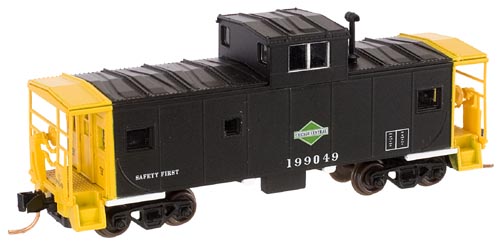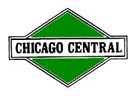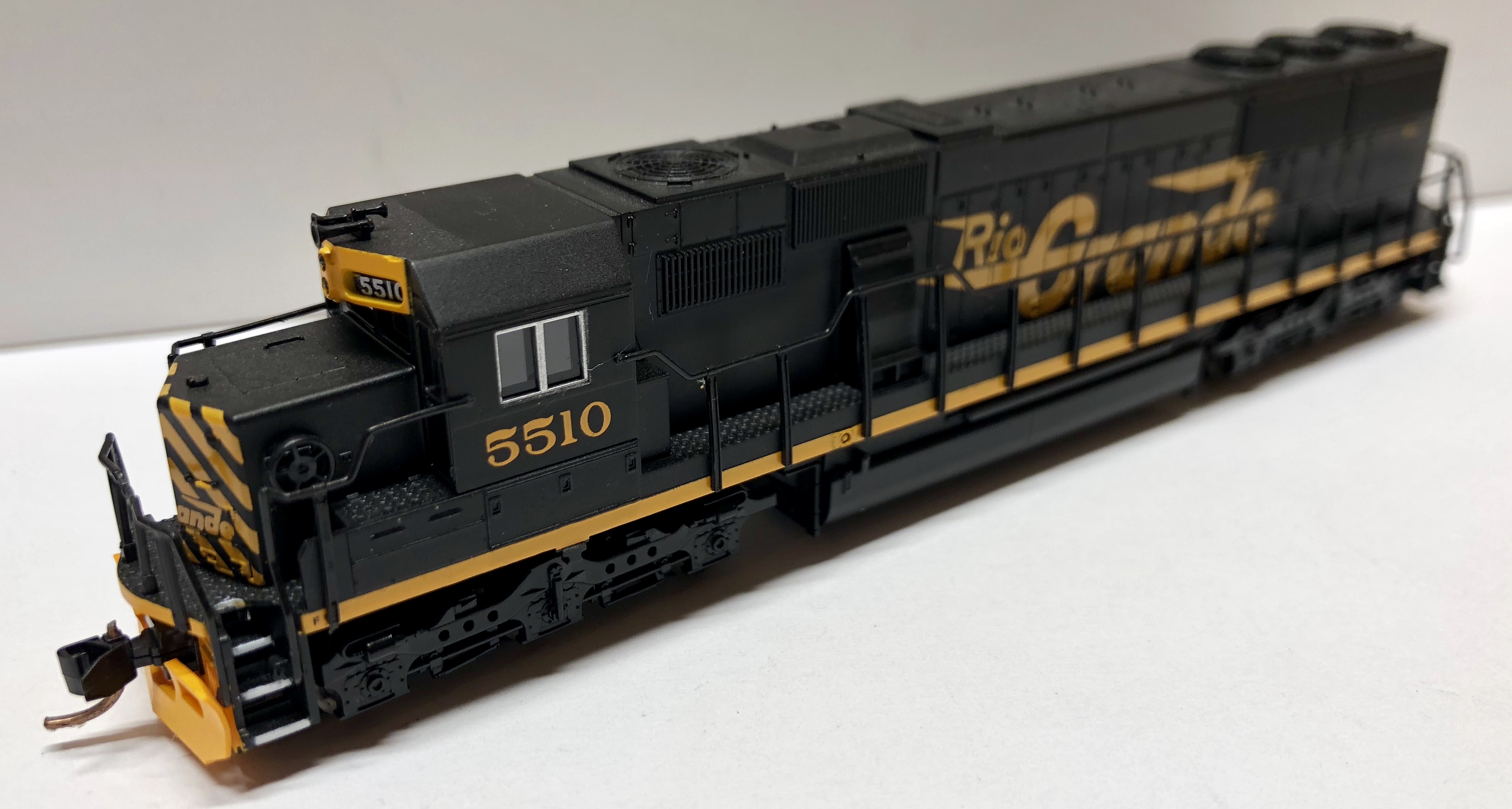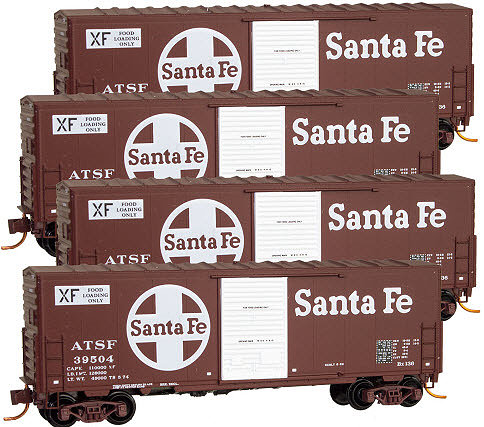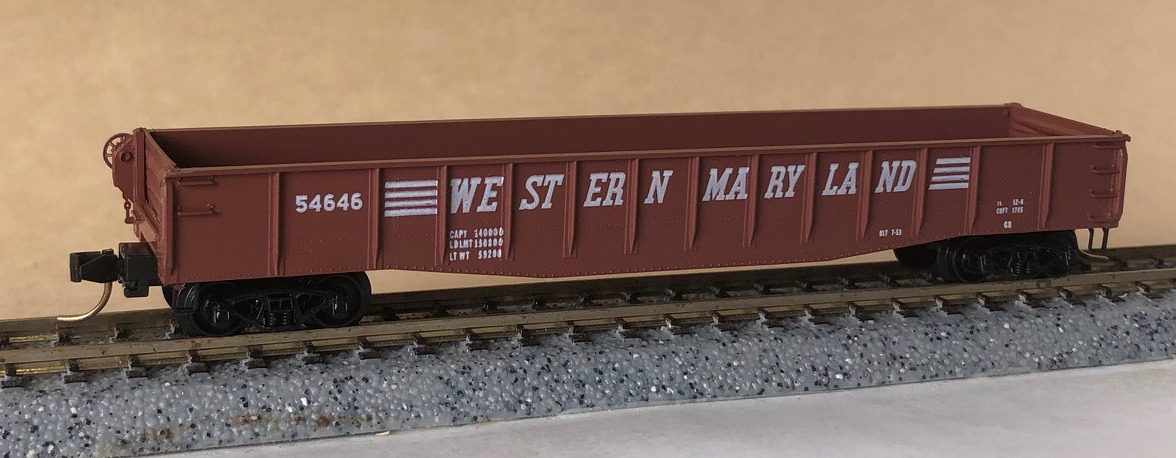Atlas - 43106 - Caboose, Cupola, Steel - Chicago Central & Pacific - 199049
Click to see the details
history
| Stock Number | 43106 |
| Original Retail Price | $30.50 |
| Brand | Atlas |
| Manufacturer | Atlas |
| Body Style | Atlas Caboose Cupola Standard |
| Prototype Vehicle | Caboose, Cupola, Steel (Details) |
| Road or Company Name | Chicago Central & Pacific (Details) |
| Reporting Marks | CC |
| Road or Reporting Number | 199049 |
| Paint Color(s) | Black/Yellow/Green |
| Coupler Type | MT Magne-Matic Knuckle |
| Release Date | 2008-02-01 |
| Item Category | Rolling Stock (Freight) |
| Model Type | Caboose |
| Model Subtype | Cupola |
| Prototype Region | North America |
| Prototype Era | NA Era III: Transition (1939 - 1957) |
| Scale | 1/160 |
| Track Gauge | N standard |
Model Information:
The Atlas "43" series cupola caboose has been around since the early 2000's. The cupola is located slightly off-center, but towards the middle of the body. It carries three windows on each body side, two larger ones at the ends and a smaller one in the middle. The cupola carries a double-window on each side. This body usually has a raised roof-walk and "loop-over" ladders but not always.
Prototype History:
The origins of the railroad caboose appear to date back to the 1840s when Nat Williams, a conductor of the Auburn & Syracuse Railroad (a later affiliate of the New York Central) became fed up with cramped and uncomfortable quarters to do paperwork (a common job of the conductor, whose responsibility is general oversight and control of a train, passenger or freight), which was usually done in either a free space of a passenger car or combine/baggage car. To fix this problem, Williams found an unused boxcar and using a simple box and barrel, as a seat and desk, set up shop in the car to do his duties. Not only did he find out he had plenty of room to work but also figured that he could use the unused space to store tools (flags, lanterns, spare parts, etc.) and other essentials to have on board whenever needed (such things become commonly stored on the caboose).
Perhaps the most striking feature ever applied to the railroad caboose was its cupola. According to the story, conductor T.B. Watson of the Chicago & North Western in the 1860s reportedly used a hole in a boxcar’s roof (which he was using as a caboose) to get a better vantage point of the train ahead. It is said that Watson was amazed by the view afforded from the position being able to not only see the train ahead but also from all sides, and to the rear as well. He apparently convinced C&NW shop forces to construct a type of open observation box onto an existing singe-level caboose with windows all around where one could sit and view their surroundings. The rest, as they say, is history and the common cupola was born.
Steel Cabooses replaced their wood-sheathed brethren after the second world war when the steel glut made the production and maintenance of steel cabooses far more efficient than wooden models. With the advancement of the End-of-Train device, cabooses slowly began to fall out of favor. However, in the early 2000’s, “shoving platforms” began to appear as a place to safely house a crew when a reverse move was required. Instead of riding on the side of a freight car, the crew member now has a safe place to stand, while guiding the rear of a reverse move.
Perhaps the most striking feature ever applied to the railroad caboose was its cupola. According to the story, conductor T.B. Watson of the Chicago & North Western in the 1860s reportedly used a hole in a boxcar’s roof (which he was using as a caboose) to get a better vantage point of the train ahead. It is said that Watson was amazed by the view afforded from the position being able to not only see the train ahead but also from all sides, and to the rear as well. He apparently convinced C&NW shop forces to construct a type of open observation box onto an existing singe-level caboose with windows all around where one could sit and view their surroundings. The rest, as they say, is history and the common cupola was born.
Steel Cabooses replaced their wood-sheathed brethren after the second world war when the steel glut made the production and maintenance of steel cabooses far more efficient than wooden models. With the advancement of the End-of-Train device, cabooses slowly began to fall out of favor. However, in the early 2000’s, “shoving platforms” began to appear as a place to safely house a crew when a reverse move was required. Instead of riding on the side of a freight car, the crew member now has a safe place to stand, while guiding the rear of a reverse move.
Road Name History:
Chicago Central & Pacific (reporting marks, CC) was one of the larger spin-offs of Illinois Central Gulf. In 1985, the new company acquired the entire Iowa Division of the ICG, stretching from Chicago west to Omaha and Sioux City (the lines diverge just west of Fort Dodge, Iowa) plus rolling stock for $75 million. Other branches off this main were also included. Total mileage is just under 800 making it a bit smaller than Maine Central in comparison.
Other than 17 former Milwaukee Road GP20s, 10 GP38s, 3 GP28s, and a quartet of switchers, the rest of the 114 unit diesel fleet was made up of former Illinois Central Gulf geeps (mostly units rebuilt at ICG's Paducah Shops.) For the first few years, typical lashups consisted of orange and white ICG units with the name painted out and the new CC green diamond logo applied to the nose and cab side, also orange and black former MILW units that received the same treatment. Ultimately, a new red paint scheme was adopted. If you removed the lettering from the long hood and painted it black instead of red, you would have Illinois Central's pre-1967 paint scheme. Ultimately, they dropped the "CHICAGO CENTRAL" from the long hood and replaced it with a larger "CC" instead. The green diamond inherited from Illinois Central with "Chicago" replacing "Illinois" remained however.
In one of life's little ironies, in 1996 the Illinois Central (they dropped the "Gulf" in 1988,) repurchased the Chicago Central & Pacific for twice what they had sold it for. Today, CC is a paper railroad owned by Grand Trunk Corporation who administers Canadian National's US holdings. There are many freshly painted Canadian National cars with "CC" reporting marks, and the line is operated as part of the greater Canadian National system.
Other than 17 former Milwaukee Road GP20s, 10 GP38s, 3 GP28s, and a quartet of switchers, the rest of the 114 unit diesel fleet was made up of former Illinois Central Gulf geeps (mostly units rebuilt at ICG's Paducah Shops.) For the first few years, typical lashups consisted of orange and white ICG units with the name painted out and the new CC green diamond logo applied to the nose and cab side, also orange and black former MILW units that received the same treatment. Ultimately, a new red paint scheme was adopted. If you removed the lettering from the long hood and painted it black instead of red, you would have Illinois Central's pre-1967 paint scheme. Ultimately, they dropped the "CHICAGO CENTRAL" from the long hood and replaced it with a larger "CC" instead. The green diamond inherited from Illinois Central with "Chicago" replacing "Illinois" remained however.
In one of life's little ironies, in 1996 the Illinois Central (they dropped the "Gulf" in 1988,) repurchased the Chicago Central & Pacific for twice what they had sold it for. Today, CC is a paper railroad owned by Grand Trunk Corporation who administers Canadian National's US holdings. There are many freshly painted Canadian National cars with "CC" reporting marks, and the line is operated as part of the greater Canadian National system.
Brand/Importer Information:
In 1924 Stephan Schaffan, Sr. founded the Atlas Tool Company in Newark, New Jersey. In 1933 his son, Stephan Schaffan, Jr., came to work for his father at the age of sixteen. Steve Jr. built model airplanes as a hobby and frequented a local hobby shop. Being an enterprising young man, he would often ask the owner if there was anything he could do to earn some extra spending money. Tired of listening to his requests, the hobby-store owner threw some model railroad track parts his way and said, "Here, see if you can improve on this".
In those days, railroad modelers had to assemble and build everything from scratch. Steve Jr. created a "switch kit" which sold so well, that the entire family worked on them in the basement at night, while doing business as usual in the machine shop during the day.
Subsequently, Steve Jr. engineered the stapling of rail to fiber track, along with inventing the first practical rail joiner and pre-assembled turnouts and flexible track. All of these products, and more, helped to popularize model railroading and assisted in the creation of a mass-market hobby. The budding entrepreneur quickly outgrew the limitations of a basement and small garage operation. Realizing they could actually make a living selling track and related products, Steve and his father had the first factory built in Hillside, New Jersey at 413 Florence Avenue in 1947. On September 30, 1949, the Atlas Tool Company was officially incorporated as a New Jersey company.
In 1985, Steve was honored posthumously for his inventions by the Model Railroad Industry Association and was inducted into the Model Railroad Industry Hall of Fame in Baltimore, Maryland. In addition, Steve was nominated and entered into the National Model Railroad Association Pioneers of Model Railroading in 1995.
In the early 1990s, the Atlas Tool Company changed its name to Atlas Model Railroad Company, Inc.
In those days, railroad modelers had to assemble and build everything from scratch. Steve Jr. created a "switch kit" which sold so well, that the entire family worked on them in the basement at night, while doing business as usual in the machine shop during the day.
Subsequently, Steve Jr. engineered the stapling of rail to fiber track, along with inventing the first practical rail joiner and pre-assembled turnouts and flexible track. All of these products, and more, helped to popularize model railroading and assisted in the creation of a mass-market hobby. The budding entrepreneur quickly outgrew the limitations of a basement and small garage operation. Realizing they could actually make a living selling track and related products, Steve and his father had the first factory built in Hillside, New Jersey at 413 Florence Avenue in 1947. On September 30, 1949, the Atlas Tool Company was officially incorporated as a New Jersey company.
In 1985, Steve was honored posthumously for his inventions by the Model Railroad Industry Association and was inducted into the Model Railroad Industry Hall of Fame in Baltimore, Maryland. In addition, Steve was nominated and entered into the National Model Railroad Association Pioneers of Model Railroading in 1995.
In the early 1990s, the Atlas Tool Company changed its name to Atlas Model Railroad Company, Inc.
Item created by: cwarczinsky
on 2016-04-20 20:44:37
Last edited by: Alain LM on 2024-09-23 04:59:44
If you see errors or missing data in this entry, please feel free to log in and edit it. Anyone with a Gmail account can log in instantly.
Last edited by: Alain LM on 2024-09-23 04:59:44
If you see errors or missing data in this entry, please feel free to log in and edit it. Anyone with a Gmail account can log in instantly.


